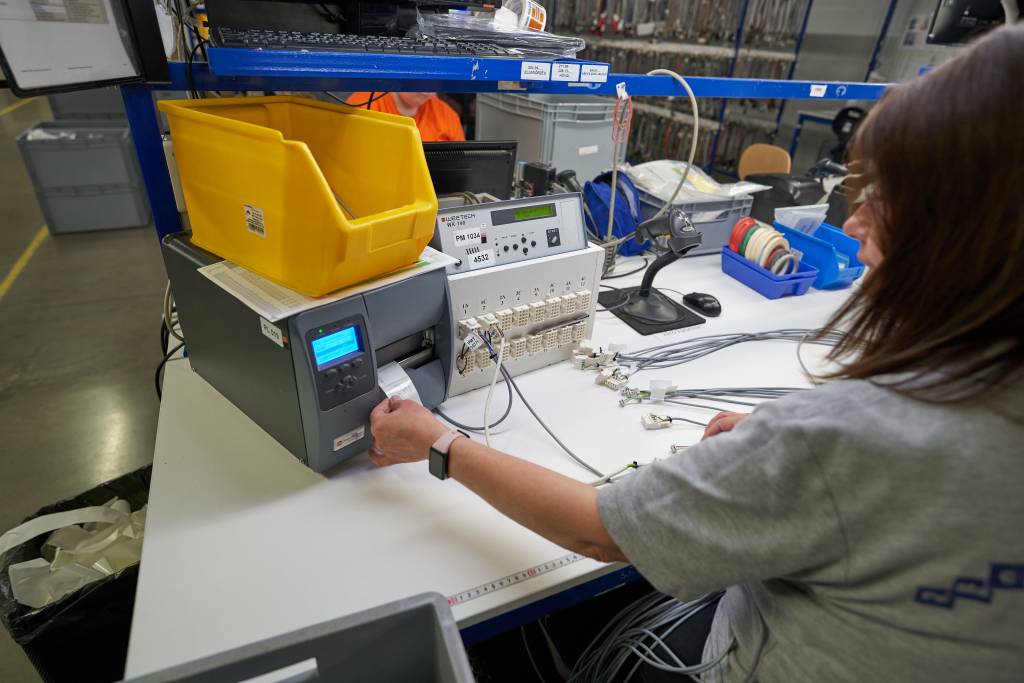

In the first step, we receive the basic data of the products the customer wants to manufacture from the employees of our Austrian parent company, H&S Kabeltechnik, in the form of a parts list and customer drawing or customer sample. The employees of the preparatory office are in constant contact with our customers and Austrian colleagues, namely they act on any questions arising in the case of any production difficulties or ideas that make production easier. After the first successful negotiations, the preparation of the production drawing can begin. This operation requires detailed knowledge of manufacturing processes to avoid foreseeable manufacturing difficulties and errors.


When printing, quality aspects such as legibility, print size and indelibility should be taken into account.

High-quality crimping determines the service life of the crimp connection. For this, it is essential that tools and machines of suitable quality are available. Crimping can be done with manual pliers, semi- or fully automatic machines. To check and maintain quality, we measure the pull-force and perform a grinding test.



By means of our semi-automatic press machines, we can process nearly 100 types of Lumberg connectors.
The machines provide the appropriate pressing height according to the standard, and correct connection can be guaranteed with the help of the built-in colour sensors.
All additional connectors are pressed with a lever press or, in some cases, with hand pliers.

One of the main strengths of PeMaC is that every single cable manufactured by us is subjected to an electrical test, in contrast to other cable assembly companies, where such tests are only carried out on a random basis. During the electrical test, we filter out pole reversals, cable breaks and short circuits. 

When soldering, metal parts are joined by a metal alloy (solder) under the influence of heat. The melting point of the solder is lower than that of the metals to be joined. From the melting temperature, the molten solder flows between the metal parts. If the soldering is correct, a strong, tight, corrosion-resistant, current- and heat-conducting connection is created between the solder and the other metals. 



The equipment works with low pressure, which enables the use of cost-saving and quickly produced aluminium molds.
We design all molds ourselves, taking into account the customers’ needs. The low injection pressure and the low processing temperature make it possible to provide mechanical protection to sensitive electronic components (circuit boards, relays, etc.) with such injection molding technology.


Areas of application of low-pressure injection molding:



Our company pays special attention to quality control, not only for the finished product, but also during sub-processes such as crimping, connector installation or cable bundling, thus ensuring 100% satisfaction of our partners. For each new cable, we produce a sample to perfect our documentation and eliminate possible errors.


The cable assemblies are made on a pre-manufactured template, thanks to the joint work of our template makers and the technical department. The production drawing and the template determine together from which point to where the wires go. Regardless of the complexity of the cable assembly, we always strive for the simplest possible solutions to enable our employees to learn the process of manufacturing the product easily.


In the PeMaC warehouse, we store the base materials necessary for the production of assemblies on 3 levels and in 4 rows. This warehouse has a floor area of 135 meters long and 15 meters wide, since proper organization and efficient movement of base materials are essential. Colleagues working in the warehouse can access the most important information, such as the location and quantity of base materials, through a computer system. The warehouse also includes 2 dynamic storage systems.
Paternoster storage systems work on the principle of circulation. Like a carousel, the goods rotate to the operator opening, where the operator can easily and safely take them out.
 Production preparation
Production preparation
 Cable cutting
Cable cutting Cable marking
Cable marking Crimping
Crimping Snapping, screwing, pressing into the housing
Snapping, screwing, pressing into the housing HOTMELT (Low pressure molding)
HOTMELT (Low pressure molding)